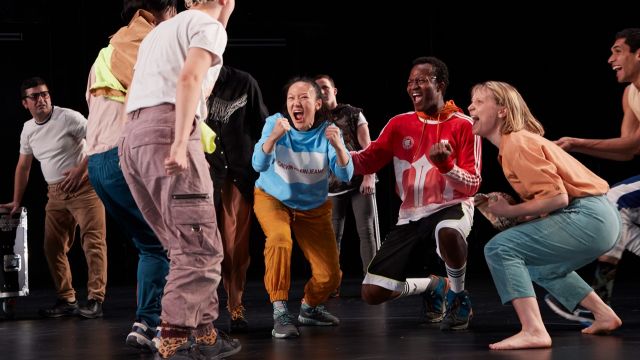William Golding’s Lord of the Flies
The audience was greeted with a blank stage – a model aeroplane was carried playfully by the cast, circling then ‘crashing’ onto the remote island where only English schoolboys have survived the accident. Bit by bit the stagecraft built. The cast thrillingly pass the conch from player to player as though they were a polished Rugby team. A scaffolding was wheeled in to signify the mountain where the boys soon climbed and lit a look out fire.
As the school boys descend into savagery the lights dim and dancing fluorescent globes descend. The hunters dash down the rows of lights like hoons on a freeway, brandishing their spears with menace as they search for the Beast. The destruction of order is matched by the splintering of wood. One piece flew out and appeared to narrowly miss a member of the audience in the front row. The most thrilling effect even saw the fabric of part of the stage shattered.
Exciting elements of sound design (James Brown), light (Alexander Berlage) and movement ebbed together in symmetry as the drama moved to its crushing conclusion.
All of this could not mask Director Kit Williams’ determination to cast against type. Williams has stated that he was told that Lord of the Flies was a story about the potential of all humans to slip into anarchy. Rather, he sees it as a reflection of gender and toxic masculine cultures.

All of the characters in the novel are white straight English boys aged six to twelve. In this production not one of the actors matched this. Not only were they all adults but there was a mixture of gender, race and sexual identity in the cast. One of the ensemble was given space in the program to discuss identifying as a non-binary and transmasculine actor.
Rahel Romahn – a Kurdish born actor – played Piggy, the intellectual school boy whose wise counsel was ignored. He was perhaps closer to the character as originally written than any other cast member. Contessa Treffone as Jack was pitted against frustrated leadership rival Ralph, portrayed by Mia Wasikowska.
The school boy who loses most control is Roger. He was portrayed by Daniel Monks, a highly skilled actor with a physical disability. His casting is a cause for celebration but I felt that he should have been cast as one of the other boys. Fantasy and horror movies have rightly been criticised for presenting disabled people as evil. This clearly was not the intention of the Director (quite the opposite) but this casting left this issue open.
For those very well versed with the text this production provided a new perspective on the work although it was rather bluntly applied. But those coming to the work for first time might find the casting against type a distraction.
David Spicer
Photographer: Zan Wimberley
Subscribe to our E-Newsletter, buy our latest print edition or find a Performing Arts book at Book Nook.

